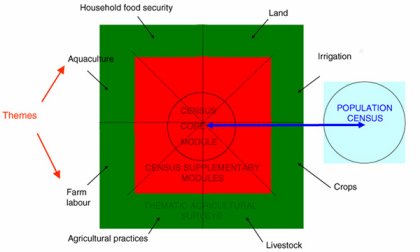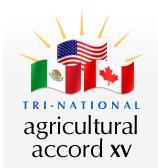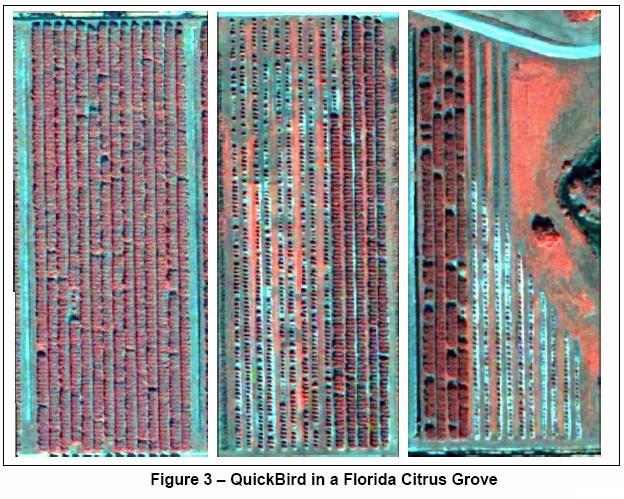Big Brother Snoop Is At It Again
January 4, 2008
2007 Agricultural Survey - Region 5
Agricultural Survey Instruction Book (large pdf)
USDA Regional Map for the Agricultural Survey
The animal information being collected is reminiscent of
another program the USDA tried to implement a few years ago.
That system was the National Animal Identification System (NAIS)
premises and animal registration system. The NAIS was
made voluntary when there was a massive citizen revolt
against the registration of premises and animals. It
seems to this writer that the USDA is using the Agricultural
Survey as a backdoor to the NAIS with the only piece missing
- the chipping of the animals and owners.
National Animal Identification System Brochure
PENALTY FOR FAILURE TO REPORT
NOTICE: Response to this inquiry is required by law (Title 7, U.S. Code). By the same law, YOUR REPORT IS CONFIDENTIAL and it will only be used for statistical purposes. Your report CANNOT be used for purposes of taxation, investigation, or regulation. The law also provides that copies retained in your files are immune from legal process.
U.S. Code, Title 7, Chapter 55, Section 2204g. specifies a $500 fine for giving false information and a $100 fine for failure to complete the form. But... didn't it say above "immune from legal process" and cannot be used for regulation? Isn't the requirement to complete the form a regulation? So confusing.
Here's where it gets fun. The Secretary of Commerce may request the survey information:
(2) Information provided to Secretary of CommerceOn a written request by the Secretary of Commerce, the Secretary of Agriculture may provide to the Secretary of Commerce any information collected in a census taken under this section that the Secretary of Commerce considers necessary for the taking of a census or survey under title 13.
So what does Title 13 say? The Bureau of the Census SHALL exchange with the Bureau of Economic Analysis of the Department of Commerce Information collected....augment and improve quality of data collected under International Investment and Trade in Services Act.... (hmmmm)
CHAPTER 10 - Exchange of Census Information
(a) Exchange of Information.— The Bureau of the Census shall exchange with the Bureau of Economic Analysis of the Department of Commerce information collected under this title, and under the International Investment and Trade in Services Survey Act, that pertains to any business enterprise that is operating in the United States, if the Secretary of Commerce determines such information is appropriate to augment and improve the quality of data collected under the International Investment and Trade in Services Survey Act. Information provided to the Bureau of Economic Analysis by the Bureau of the Census shall be only those data collected directly from respondents by the Bureau of the Census.
The statistics are actually held by the National Agricultural Statistics Service (NASS). The NASS webpage has the information about the 2007 Census. On the bottom right of the screen, you'll see the 2007 Census logo. If you click on it, it will take you to the Census information page as described above. However, as I was searching around for info, I hit the back button from the Census information page to go back to the main page. Rather than the Census graphic however, there was a different graphic - the one you see on the right below. When I clicked on it, it took me to the North American Tripartite Committee on Agricultural Statistics. WHOA!
This morning the NATCAS website was down. Fortunately I captured the mandate page "just in case". You can view it HERE
The following two links are reports that were found on the NATCAS website. The first is the mandate for the working groups for Canada, U.S. and Mexico to produce a combined report. The second link is the first three pages of the combined report.
First Three Pages of the combined U.S., Canada, Mexico Agricultural Statistics Report
The
Wikipedia entry on the National Agricultural Statistics
Service (NASS) mentioned an organization named the
National Association of State Departments of Agriculture
(NASDA). The entry made the claim that NASS contracted
with NASDA for the services of the enumerators (census
takers). It's a good idea to verify Wiki entries - so
I did and found this reference to a
Memo of Understanding on the NASS website:
"NASDA is a nonprofit, nonpolitical organization comprised of the 50 State Departments of Agriculture. NASDA and USDA-NASS have a cooperative agreement for NASDA to employ enumerators in the collection of agricultural statistics."
Forget the part about "comprised of 50 State Depts..etc." NASDA is a private sector, non-profit organization which doesn't mean they don't make money. It just means that they don't report their earnings as profits on tax statements. The profits are distributed in the form of salaries, etc.
To be perfectly blunt, these outside government organizations comprised of government officials are the mechanism of legalized bribery and payoffs. They make themselves appear as if they are acting in the capacity of government interest - but as you can see by the MOU, they have outside business interests - and they can take money from the private sector (multinationals and foundations) as well as grants and contracts from government. In effect, they are using their public capacity for private profit - for themselves. When you click on the link to get to the NASDA website, look at the 'Trade Shows and Events'.
The arrangement of government officials working through private organizations allows for the cooperative participation in violation of the Constitution and the bounds of law within which government employees work.
For more information, on the Third Way - privatization of government, read the following:
CRS - Privatization of Government
Market Based Governance
"Government of the Future"
Key Principles...."Partnership Agreements"
xxxxxxxxxxxxxxxxxxxxxxxxxxxxxxxxxxxxxxxxxx
National Association of State Departments of Agriculture (NASDA)
Notice that NASDA is organized into regions. Regionalization is the mechanism of cannabalization of elected, representative government. It is the enabling mechanism for the treason of the North American Union.
On the NASDA website, under the heading of NASDA Committees, it describes the Marketing and International Trade Committee as follows - keeping in mind that NASDA is a private, non-profit organization:
Marketing and International Trade Committee
Focus on issues related to domestic marketing and promotion programs; marketing orders; specialty crops; global and regional international trade agreements; harmonization of technical standards, inspection and regulatory programs; marketing of agricultural biotechnology products; programs to provide food aid and technical assistance regarding agricultural matters to other countries; and other similar matters. The committee also oversees the activities of the working groups established under the Tri-National Agricultural Accord.
2008 Tri-National Agricultural Accord - Coeur D'Alene, Idaho
According to the NASDA history page, the Tri-National Agricultural Accord began in 1992. This was actually before the NAFTA agreement was signed. And it was during the timeframe when Al Gore and Bill Clinton were "reinventing government" - as we see now, in the Third Way - Fascist-Communist system.
Interestingly, they seem to have a different story on different pages. This page says that the Tri-National Agricultural Accord began in 1986 - with the Canadian FTA.
Additional Information on the Tri-National Agricultural Accord can be found using these links:
NASDA -
Information page on Tri-National Agricultural Accord
2007
Tri-National Annual Meeting Website
NASDA Committee Report - 2005 (Public Citizen)
From USDA-NASS Website - Link for
Tripartite NA
Statistics for the United Nations
In 2007, the FAO Fourth International Conference on Agricultural Statistics was held in Bejing. The Powerpoint Presentation indicated that the presentation was about 'Small Island Developing States' (SIDS), but as everybody who has ever studied the UN Agenda and Programmes understands, the UN is a Communist organization and that which applies to one country applies to all countries regardless of size. And in fact, the same concepts in the Bejing document were discussed at the Mexsai conference a few years earlier and the USDA participated in that conference.
A pdf from the Powerpoint - just in case the PP is taken down.
FAO Conference on Agricultural Statistics PDF
Excerpts:
Resource - funding challenges... "One solution is to conduct a 'national census programme' and to plan the census of agriculture and the census of population and housing as a joint exercise under one funding envelope" p4 (note: the reason this webpage was written is because the 24-page agricultural survey was sent to a person who resides in a rural area - but is not engaged in commercial agricultural activities - and never has been so effectively the USDA is combining Census and Agricultural collection of statistics - lumping non-commercial and commercial statistics together creating "an integrated system of food and agricultural statistics".
"In considering the institutional arrangements, it should be noted that the census of agriculture as made up of a statistical component (census) and a thematic component (agriculture)" pg. 6 (See Title 13 above. Also, at the 3rd Conference in Mexsai, a paper was presented explaining the 'thematic approach')

"The need to institutionalize this relationship between the NSO [National Statistics Office] and the line ministry in developing and implementing an integrated system of food and agricultural statistics, within the broader context of the National Statistics System, is considered an essential pre-requisite for the success of the census of agriculture. pg. 6
"The new FAO guidelines for WCA2010 adopts a new approach to agricultural census taking with emphasis on conducting a ‘core’ module through complete enumeration and ‘supplementary’ modules(s) on a sample basis." (In other words, combined census and agricultural statistics).
"The bulk of the human resource skills, to the extent they do exist, will be found in the NSO" P6 (Note: In the U.S. human resource skills are being reported and aggregated through the integrated school-workforce development system)
Mary, Mary. Quite
Contrary. How Does Your Garden Grow?
"The issues of
"The Household Income and Expenditure Survey (HIES), could be a vehicle for measuring such production for own consumption. Limitations include small sample size for the HIES limiting any geographical breakdown and the data reliability for the less common items." p11
Relationship between Census of Population and Housing and the Census of Agriculture: made, through the unique household identification number, to provide a much richer data set than would be possible through two separate statistical exercises... Lastly, by institutionalising the arrangements for the conduct of the two censuses as an integrated exercise will ensure that the census of agriculture is conducted on a regular basis in future rounds. p18 (Unique household identifier - sounds a lot like NAIS premises registration doesn't it?)
Establishing a much closer relationship between the census of population and housing and the census of agriculture is recommended both by the United Nations Statistical Division (UNSD) and the Food and Agriculture Organization of the United Nations (FAO) in their respective census programmes for the 2010 round of censuses. p19
Third International Conference on Agricultural Statistics at Mexsai
Star Tree Diagram (be sure to click on the tabs)
Mexsai - Papers and Presentations
"Another useful GIS based tool comes from the National Agricultural Statistics Service remote sensing program. We can use satellite images to generate a mosaic of crop fields with the crop type labeled by field. This is called a cropland data layer and would be quite useful to map the locations of susceptible crops relative to fields containing a particular problem. This cropland data layer is currently a standard product for several States on an annual basis but the methodology is in place to apply where needed." International Interests in Agriculture and Rural Statistics
Does Any Of This Seem Like It Belongs In a Free Enterprise System?

